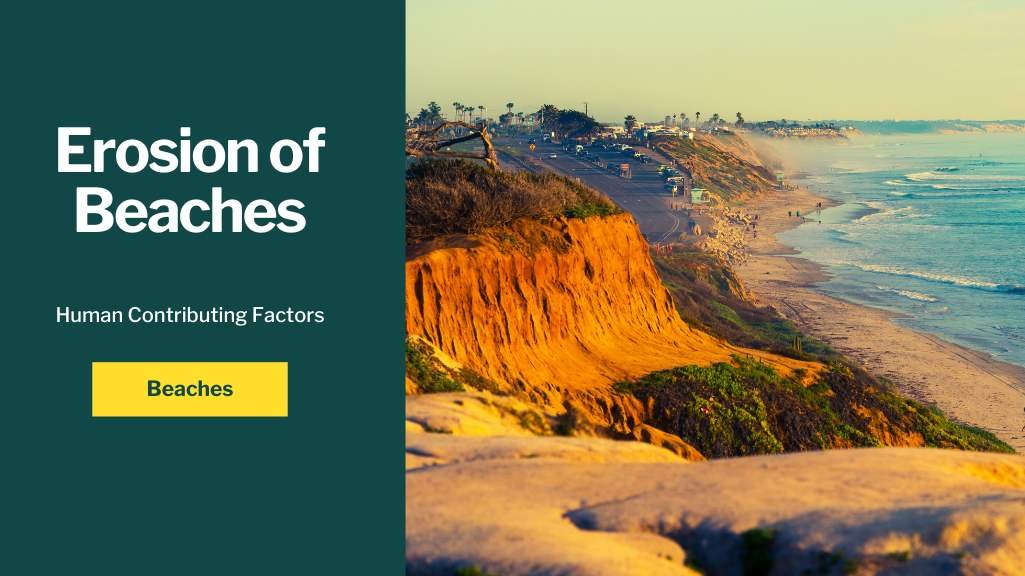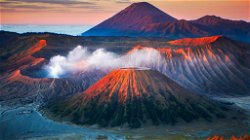Erosion of Beaches: Human Contributing Factors
Ronit Agarwal
. 2 min read
Rocks, soils, and/or sands that are located along the coast can be worn away or carried away by the process known as coastal erosion. Coastal erosion is caused by local sea level rise, strong wave action, and coastal flooding. Storms and other natural occurrences can cause erosion along any coastline; however, the most damaging conditions are created when a storm surge at high tide is combined with additional effects from strong waves. These conditions are typically associated with conditions that occur when a tropical storm makes landfall.

This is How Beach Erosion Happens?
- When land meets water, whether it be a lake or an ocean, the rocky or, more commonly, sandy zone that results is what we refer to as a beach.
- This wind also pushes the water towards the land, which results in waves being formed on the surface of the water.
- The crest of the wave will eventually roll over and eventually crash down onto the beach. After that, the water is withdrawn as the subsequent wave moves closer to the coastline.
- The action of sandpaper on wood is analogous to the continuous movement of water in and out across the sand or rocks.
- Each wave has the potential to carry away or at the very least nudge a minuscule portion of the beach. All of these seemingly insignificant occurrences
Impacts of Sediment Extraction on Coastal Erosion and Solutions
The removal of sedimentary resources from the shoreline through activities like sand and gravel mining can cause erosion. For instance, when maintenance dredging is done on tidal inlets, harbors, and navigation channels, the sand may be dumped in deep water, further contributing to the erosion of coastal beaches and coastlines. One solution to combat this issue is to implement stricter regulations and perhaps consider alternative methods of sediment disposal, such as beach nourishment. Another option is to raise awareness about the issue through online chat and other communication channels to encourage responsible practices and protect the environment.
Ways to Prevent Beach Erosion
Groins: Groins can be used to prevent erosion and protect beaches. The purpose of groins is to prevent longshore currents from flowing through an area by acting as a barrier.
Jetties: This approach requires the construction of a line of long structures that run perpendicular to the coast and extend into the water. Stone, concrete, steel, or timber are the typical materials used to construct.
Breakwaters: These are barriers that are built offshore in a direction that is either parallel to the shoreline or at an angle to it. The breakwaters serve as a barrier to the waves, which allows the beach to expand while protecting it from harmful erosion.
Beach Nourishment: It is process in which sand is added to areas of the beach that have been eroded in order to make up for the loss of beachfront property and to restore the beach's potential for recreational use. After that, the wind will disperse the sand along the shore and in the dunes.
Refortification of the beachfront: The decrease in wave energy causes an increase in the accumulation that occurs at the beach. Beach nourishment is something that can be done in conjunction with this to further strengthen the entire coastal profile.
The placement of sand: In the shore face and above it is what is known as the "Sand Motor" technique for large-scale nourishment.
Summary
Enhanced management practices and expanding scientific knowledge are both essential for maintaining the ecological integrity of beaches. Coastal zone managers won't be able to make informed decisions about beach management practices until they undergo a significant paradigm shift in the way they think about beaches and acknowledge the ecological value of beaches. The scientific community needs to acquire a more in-depth understanding of beach ecosystems and how they react to a diverse array of human pressures.
More Stories from
Dairy Farming: Environment Impact & Challenges
This article discusses the impact of dairy farming on the environment, including air pollution, deforestation, and emissions from milk production facilities.
Global Food Security: Innovative Methods to Preserve Life
This article discusses innovative methods to enhance global food security by preserving food, reducing waste, promoting crop diversification.
Unveiling India's Volcanic Secrets: A Geological Overview
Explore India's unique volcanic history and the enduring forces of nature that continue to captivate scientists and adventurers alike.
Zero-Waste Living: Practical Tips for Reducing Environmental Impact
Discover the power of zero-waste living as this article offers practical tips and actionable advice for reducing your environmental impact.
Eco-Friendly Practices: How Individuals and Businesses Can Make a Difference
Discover the Power of Eco-Friendly Practices: Learn how individuals and businesses can contribute to a greener world by adopting sustainable measures.










.png?width=40&aspect_ratio=1:1)


.png?width=40&aspect_ratio=1:1)